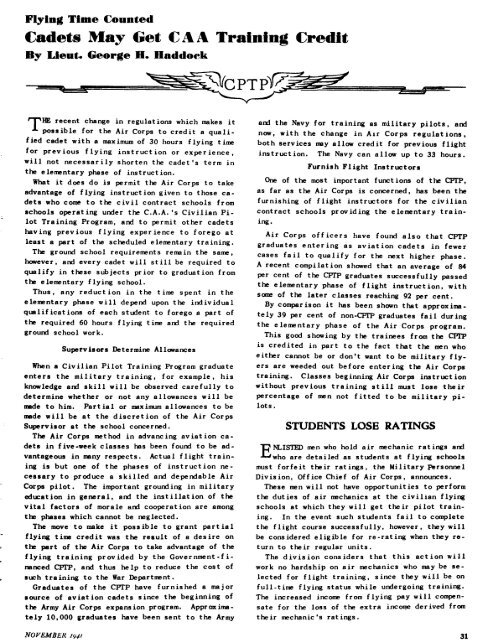News Letter 1941 Jul-Dec - Air Force Historical Studies Office
News Letter 1941 Jul-Dec - Air Force Historical Studies Office
News Letter 1941 Jul-Dec - Air Force Historical Studies Office
Create successful ePaper yourself
Turn your PDF publications into a flip-book with our unique Google optimized e-Paper software.
Flying Time Counted<br />
~adets May Get ~AA Training ~redlt<br />
By Lieut. George D. Daddoek<br />
THE r~cent change in regulat ions which makes it<br />
possIble for the <strong>Air</strong> Corps to credit a qualified<br />
cadet with a maximum of 30 hours flying time<br />
for previous flying instruction or experience,<br />
will not necessarily shorten the cadet's term in<br />
the elementary phase of instruction.<br />
What it does do is permit the <strong>Air</strong> Corps to take<br />
advantage of flying instruction given to those cadets<br />
who come to the civil contract schools from<br />
schools operating under the C.A.A. 's Civilian Pilot<br />
Training Program, and to permit other cadets<br />
having previous flying experience to forego at<br />
least a part of the scheduled elementary training.<br />
The ground school requirements remain the same,<br />
however, and every cadet will still be required to<br />
qualify in these subjects prior to graduation from<br />
the elementary flying school.<br />
Thus, any reduction in the time spent in the<br />
elementary phase will depend upon the individual<br />
qualifications of each student to forego a part of<br />
the required 60 hours flying time and the required<br />
ground school work.<br />
Supervisors Determine Allowances<br />
When a Civilian Pilot Training Program graduate<br />
enters the military training, for example, his<br />
knowledge and skill will be observed carefully to<br />
determine whether or not any allowances will be<br />
made to him. Partial or maximum allowances to be<br />
made will be at the discretion of the <strong>Air</strong> Corps<br />
Supervisor at the school concerned.<br />
The <strong>Air</strong> Corps method in advancing aviation cadets<br />
in five-week classes has been found to be advantageous<br />
in many respects. Actual flight training<br />
is but one of the phases of instruction necessary<br />
to produce a skilled and dependable <strong>Air</strong><br />
Corps pilot. The important grounding in military<br />
education in general, and the instillation of the<br />
vital factors of morale and cooperation are among<br />
the phases which cannot be neglected.<br />
The move to make it possible to grant partial<br />
flying time credit was the result of a desire on<br />
the part of the <strong>Air</strong> Corps to take advantage of the<br />
flying training provided by the Government-financed<br />
CPrP, and thus help to reduce the cost of<br />
such training to the War Department.<br />
Graduates of the CPrP have furnished a major<br />
source of aviation cadets since the beginning of<br />
the Army <strong>Air</strong> Corps expansion program. Approximately<br />
10,000 graduates have been sent to the Army<br />
NOVEMBER 194/<br />
and the Navy for training as military pilots, and<br />
now, with the change in Au Corps regulat ions,<br />
both services may allow credit for previous flight<br />
instruction. The Navy can allow up to 33 hours.<br />
Furnish Flight Instructors<br />
One of the most important funct ions of the CPrP,<br />
as far as the <strong>Air</strong> Corps is concerned. has been the<br />
furnishing of flight instructors for the civilian<br />
contract schools providing the elementary training.<br />
<strong>Air</strong> Corps officers have found also that CPrP<br />
graduates entering as aviation cadets in fewer<br />
cases fail to qualify for the next higher phase.<br />
A recent compilation showed that an average of 84<br />
per cent of the CPrP graduates successfully passed<br />
the elementary phase of flight instruction, with<br />
some of the later classes reaching 92 per cent.<br />
By compar ison it has been shown that approximately<br />
39 per cent of non-eprp graduates fail during<br />
the elementary phase of the <strong>Air</strong> Corps program.<br />
This good showing by the trainees from the CPI'P<br />
is credited in part to the fact that the men who<br />
either cannot be or don't want to be military flyers<br />
are weeded out before entering the <strong>Air</strong> Corps<br />
training. Classes beginning <strong>Air</strong> Corps instruction<br />
without previous training still must lose their<br />
percentage of men not fitted to be military pilots.<br />
STUDENTS LOSE RATINGS<br />
ENLISTED men who hold air mechanic ratings and<br />
who are detailed as students at flying schools<br />
must fode it the ir rat ings, the Mil itary Personne I<br />
Division, <strong>Office</strong> Chief of <strong>Air</strong> Corps, announces.<br />
These men will not have opportunities to perform<br />
the duties of air mechanics at the civilian flying<br />
schools at which they will get their pilot training.<br />
In the event such students fail to complete<br />
the flight course successfully, however, they will<br />
be considered eligible for re-rating when they return<br />
to their regular units.<br />
The division considers that this action will<br />
work no hardship on air mechanics who may be selected<br />
for flight training, since they will be on<br />
full-time flying status while undergoing training.<br />
The increased income from flying pay will compensate<br />
for the loss of the extra incOme derived from<br />
their mechanic's ratings.<br />
31
















